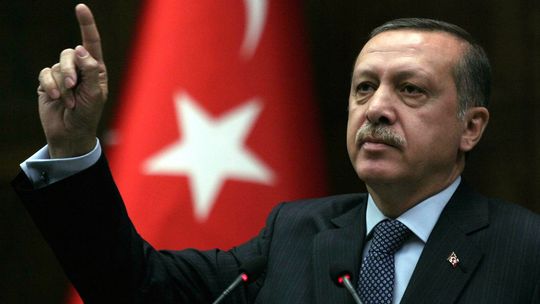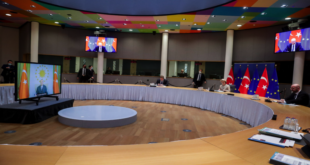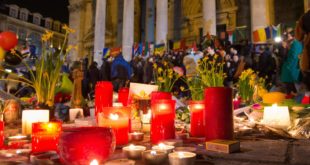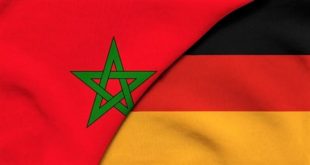Since the Justice and Development Party (AKP) came to power in Turkey’s 2002 election, Ottoman nostalgia has played an increasing role in state policy. Often termed “neo-Ottomanism”, this was initially used to define the AKP’s foreign policy. Preaching the principle of “zero problems” with neighbours, then-Prime Minister Erdoğan’s government sought to increase Turkey’s influence across the old Ottoman Empire without resorting to conflict.
With Erdoğan having moved into the presidency, the main theorist of this approach, Ahmet Davutoğlu, now occupies the position of Prime Minister. On March 3rd, 2013, he laid out the Ottoman-inspired “zero problems” policy as follows:
“Without making war, declaring anyone an enemy or violating any rules, we will reconnect Sarayevo to Damascus, Benghazi to Erzurum, to Batum. (…) Today, they may seem to you completely different countries, but 110 years ago, Yemen and Skopje were parts of the same country, as were Erzurum and Benghazi…
“They call us neo-Ottomans. It is an honour to be mentioned with the Ottomans, the Seljuks, the Artukids, Eyyoubi. However, we never wish to use our history to seize territory from other countries. Those who reconnected European countries are not considered neo-Romans, but those who connected Middle East countries to each other are considered neo-Ottomans”.
He added:
“those who want to provoke conflicts betweem Shiite and Sunni, Turk and Kurd, Arab and Kurd, Muslim and non-Muslim must not succeed. It is our duty to re-establish a new order in this region and we will work day and night to do so”.
President or Sultan?
Even if not directly confrontational, neo-Ottomanism is far from benign. On the contrary, the discourse is central to Erdoğan’s attempts to centralise power around himself, at the expense of Turkey’s parliamentary democracy. After holding the Prime Ministership for over ten years, Erdoğan is now presented as a new “Sultan” following his election as President. The last two years in particular have seen the AKP leader accused, with increasing regularity, of authoritarianism by political opponents.
However, this “strong man” persona also works in Erdoğan’s favour. This is particularly evident in his aggressive posture vis-à-vis Israel, signified most memorably by the famous “one minute” speech – Erdoğan’s angry explosion against Israel’s then-President, Shimon Peres, at the 2009 Davos Summit. Ostensibly a defence of Palestinian rights, this rant also served to bolster Erdoğan’s own image. According the historian Kadir Mısıroğlu:
“The opposition to Israel of the current [Turkisk] government, beginning with the ‘one minute’ incident, is…[a display of] bravery, of heroism, [intended to engender] the same kind of elation as when a sick person is suddenly cured on their deathbed…
The howling against Islamophobia abroad also reminded people of their own personality and culture. It [the ‘one minute’ speech] was the sound of the footsteps of the imperial past, manifested through Tayyip Erdoğan”.
The image of this Ottoman spirit was further embellished by Turkey’s recovery of the remains of Suleiman Shah, grandfather of the founder of the Ottoman dynasty, Osman I. On 21st to 22nd February, Turkish forces raided ISIS-controlled territory in Syria to recovery Osman’s bones, reburying the remains in a temporarytomb within Kurdish-controlled areas of Syria, around the recently liberated city of Kobane.
Along with apparent co-ordination between Turkish, Syrian Kurdish and PKK forces, this operation served to underline the protective nature of the Ottoman Empire: whatever the ethnicity of the victim, neo-Ottoman Turkey ran to the rescue. Erdoğan’s regime thereby positioned itself within a historical legacy exemplified by the protection given by the Ottoman Empire to Jews expelled by Isabella I and Ferdinand II of Spain following the Reconquista, hoping thereby to further its image as a benevolent regional hegemon.
Redefining Turkey
Domestically as well, Erdoğan’s neo-Ottoman posture has a precise political purpose: namely to reconstitute Turkish identity on the basis of the old Islamic empire and marginalise the legacy of the Kemalist republic. Naturally, such social engineering stands to benefit the AKP over its main rivals in the election, most notably the Republican People’s Party (CHP), founded by Ataturk.
Moves in this direction were seen during Erdoğan’s campaign for the presidency in 2014. As a candidate, the AKP leader instructed supporters to wave Turkish flags without any symbol other than the crescent and star – or, if they so desired, the three crescent flag carried by Ottoman armies. As a “grandson of the Ottomans”, Erdoğan declared he would be proud to see such flags at marches.
After his election, Erdoğan moved into the new Presidential Palace, Ak Saray. Replacing the Çankaya Palace, Ak Saray is explicitly presented in Ottoman terms. This can be seen in Erdoğan’s pointed use of the Arabic word “külliye”, rather than the European “complex”, to describe the project: a tactic he has also used to describe the madrassas, libraries, hospitals, soup kitchens and wells around mosques. Similarly, during the opening ceremony of the campus of Esenboğa of Yıldırım Beyazıt University, he suggests using the same Arabic word instead of the French word “campus (kampüs in Turkish)”, presenting the külliye as the Ottoman model of university.
The links with the past are highlighted by the Turkish President in different ways. The first guest received at Ak Saray was Mahmoud Abbas, the president of the Palestinian Authority. Welcomed on January 12, 2015, Abbas was greeted with a parade of soldiers dressed in the uniforms of the sixteen historical Turkic states which preceded the present-day Republic.
Azerbaijani leader Ilham Aliyev was similarly received on January 20, 2015 by his Turkish counterpart with a rendition of the Ottoman anthem of the Resurrection (Diriliş). Five days later, President Erdoğan was welcomed at the Mogadishu airport by Somali President Hassan Sheikh Mohamoud with the same song. This is probably a way to thank Turkey for, among other things, the hospital it built via its Turkish Cooperation and Coordination Agency (TIKA) in the Somali capital.
Likewise, during the anniversary ceremony commemorating the death of the founder of the Turkish Republic, Atatürk, on November 10, 2014, Erdoğan stated that the Republic is the continuation of the Malazgirt war of 1073, the foundation of the Ottoman Empire in 1299 and the conquest of Constantinople by Sultan Mehmet II in 1453.
Less ostentatiously, the educational curriculum has also been changed. Erdoğan has introduced the Ottoman language – ancient Turkish written in Arabic alphabet – into schools. In order “to prevent younger generations losing touch with their cultural heritage”. Responding to heavy criticism, Erdoğan stated: “Regardless of whether they want it or not, Ottoman will be taught and learned in this country”, apparently to remedy the fact that very few Turks are able to read thousands of documents on their history that are in big archives.
Through such measures, rather than a distinct rupture with the past, present-day Turkey is situated within a historical continuum, with the AKP its natural leaders.
Strengthening Erdoğan’s Powerbase
Ottoman nostalgia has proven to be contagious. Once elected in March 2014, Adnan Yaşar Görmez, the mayor of Torbalı district of Izmir, hung a portrait of Sultan Abdülhamid II and the coat of arms of the Ottoman Empire on his office wall. His city council was one of the first to support the teaching of the Ottoman language.
According to critics, the legacy of the Empire is being instrumentalised by followers of Erdoğan to cement his power. The AKP MP for the city of Balıkesirm and boss of a flower factory, Tülay Babuşcu, posted on Twitter a photo of the Turkish and the Palestinian presidents in front of the 16 soldiers, mentioned above. Below the picture, she wrote:
“This (…) must be understood. The Ottoman Empire, destroyed for not surrendering Palestine, is now the background image for the leader of the Palestinian state and our President. A magnificent genius. This is the end of a 90-minute advert break in a 600-year-old Empire”.
Is this “advert break” the 92-year-old Kemalist Republic? Babuşcu responded to criticism a few days later, saying “Friends, this is the end of the advert break, shooting for the film has begun. Whether you like it or not, it will be released in 2023”. Cleary, this was a reference to the hundredth anniversary of the Republic, which will take place in that year.
According to Bora Edin from Sözcü, an anti-AKP newspaper, there are financial interests behind this Ottoman nostalgia. He alleges that the factory (Lalesan), created by the MP and her husband in 2009, now meets 45% of demand of flower bulbs in Turkey. Among major customers are the city halls of Istanbul and Ankara, led by the AKP.
Also tapping into Ottoman heritage is Osman Yavuz, a candidate for the nomination of the AKP in the city of Konya for the parliamentary elections of 2015. Yavus has erected billboards in which he poses in an Ottoman turban. As he says himself, he was inspired by the recent TV series, Diriliş, set in the period of Ertuğrul Gazi, the father of the founder of the Ottoman dynasty, Osman I.
Further support for Erdoğan’s neo-Ottomanism comes from the “Ottoman Centres” (Osmanlı Ocakları), an association founded in 2009. These were created in the model of the far-right nationalist “Young Wolf” centres (Ülkü Ocakları) of the 1980s, reportedly at the request of Erdoğan himself.
Although there is no official link between the association and the AKP, the former does not hide its unconditional support for Erdoğan. This has been made abundantly clear by the AKP vice president, Beşir Atalay, who in December 2014 put the backing of the Centres down to Erdoğan’s championing of the “Ottoman Mission”. The president of the association himself, Kadir Canpolat, has also asserted this alliance, stating that “just as a proponent of Sufism with no followers is the devil, the leader of an institution with no leader is the devil”.
Before the presidential elections, Conpolat explicitly declared his support for Erdoğan, saying that:
“Istanbul will be conquered again, and the one who will conquer it is the great leader of the new Turkey, our Prime Minister and our presidential candidate [Erdoğan]. And we are members of a moral, religious, and tolerant association who follow him. There is a leader who has taken on the Ottoman mission, dressed in a halo to serve his people. And we are the soldiers standing in the halo of this leader”.
This quasi-deification of Erdoğan signals that the members of the Ottoman Centres are prepared to follow the President even until death. Underlinin the point, in a press statement Erdoğan is presented as the “honor (namus)” of Ottoman Centers. The association has also organized recitation days of the surat Al Fath(The Victory), repeating the 48th Quranic verse 200,000 times in Erzurum and 1 million times in Diyarbakır, to protect Erdoğan from the violent diatribe of Fethullah Gülen, the leader of the religious community known as the Cemaat. This movement has condemned the President and his party as “corrupt” and prayed for “the divine fire [to] fall on their homes”.
Indeed, for some time now, the Cemaat has been the number one enemy of the AKP government and President Erdoğan, who claim that the state apparatus has been infiltrated by supporters of the religious community. In response, many policies of the AKP, such as the peace process between Ankara and the PKK and relations with Alevis are defended by the Ottoman Centres, which declare: “O enemy now be afraid, grandsons of the Ottomans are united”.
In addition, a second association, the Ummah’s Centers (Ümmet Ocakları) created in January 2015, offers absolute support for President Erdogan, who is even accepted by the Head of the Association, Emin Canpolat, as the leader of the Ummah. After the merging of the Ummah’s Centers with the Ottomans Centers on February 24, 2015, Canpolat applied for AKP candidacy in the first district of Ankara in parliamentary elections in June. Campaign slogans include: “He is the grandson of the Ottomans” and “The state that will live forever”. The president of the Ottoman Centres declined the invitation of the AKP to runing the elections, but hailed Erdoğan as a “man of the people (Milletin Adamı)”. The representative to the Assembly of the Ottoman Centers will be Canpolat, if he is elected.
Ottoman nostalgia enjoys strong support not in high-profile positions of state, but in large segments of society. During a march under the slogan “We are Ottoman (Biz Osmanlıyız)”, organized by a Naqshbandi community, Sakarya Naksibendi Dergâhı amd led by Mullah Mustafa Sakaryevi, participants demanded the return of the Ottoman State and some wore the fez. Banned under the Hat Law of 1925, this is a clear attempt to connect with Turkey’s pre-Republican imperial heritage. The Mullah announced that the Ottomans and, by extension, the Turks today are the “lions of Allah on earth” because “the Ottoman Empire has best lived Islam, presented the best example as a Muslim state, and was the standard-bearer of Islam for a thousand years”.
According to the Mullah, Turks have been “under narcosis” for eighty years, forgetting their names and alphabet. The weakening and demise of the Empire is blamed on foreign powers, which benefited from the chance to exploit the natural resources of oppressed people in the Ottomans’ absence.
Such examples illustrate how Erdoğan’s preaching of Ottoman nostalgia from the height of the state has encouraged others to openly express a desire to regain this heritage. After having first appeared in foreign policy, neo-Ottomanism is now employed for domestic purposes: rejecting the idea that the Republic represents a rupture with Turkeys imperial and Islamic past, this discourse places Erdoğan and the AKP at the forefront of a cultural, political and religious revival, as defenders of oppressed people, guarantors of peace and guardians of justice worthy of their glorious history.
A Battle for Turkish Identity
However, despite – indeed, because of – its power, this turn towards neo-Ottomanism is provoking a reaction from those who claim that it represents an act of revenge against the Kemalist Republic. This secular nationalist tradition also has widespread resonance, associated with the war for liberation and foundation of modern Turkey. Party politics is only likely to become more polarised around issues of Turkish identity, with opposing traditions mobilised against one another. Erdoğan has the upper hand, for now.
The views expressed in this article are the author’s own and do not necessarily represent ForMENA’s opinion.
 ForMENA Council for MENA affairs
ForMENA Council for MENA affairs




